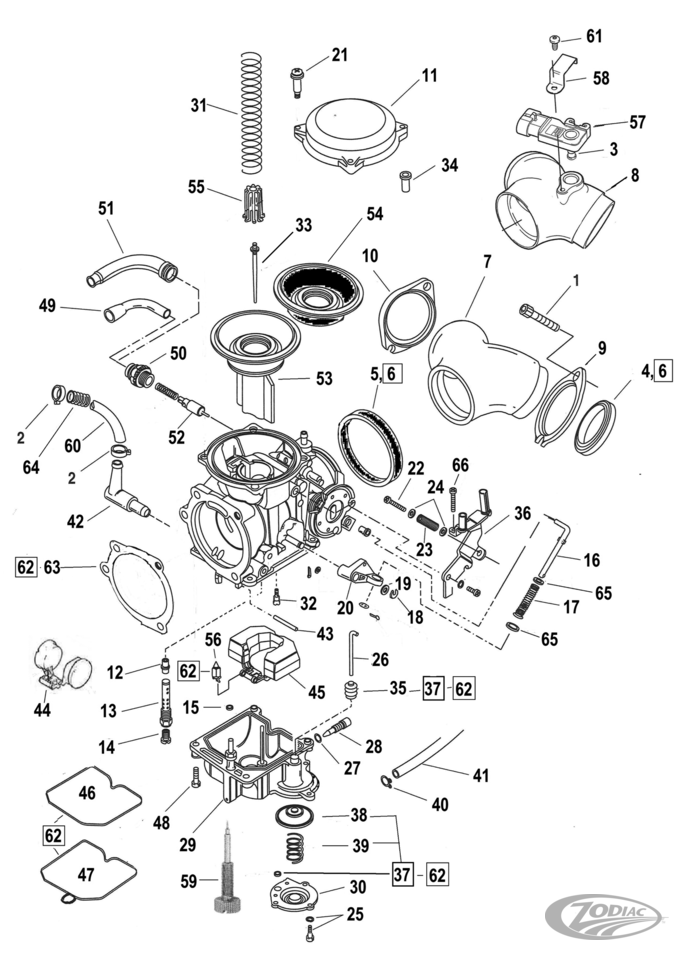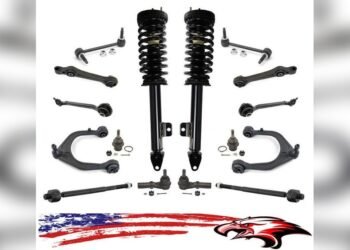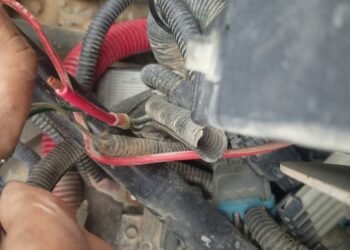Troubleshooting a Harley Davidson CV carburetor often involves checking for clogs and ensuring proper float bowl level. Common issues include erratic idling and poor throttle response.
Harley Davidson motorcycles are renowned for their robust performance and distinctive sound, a large part of which comes from their carburetion system. The CV (Constant Velocity) carburetor, in particular, plays a crucial role in ensuring the engine runs smoothly by mixing the right amount of air with fuel.
Riders may encounter problems such as a rough idle, difficulty in starting, or a noticeable decrease in acceleration. These issues signal the need for troubleshooting the CV carburetor. Understanding the common problems and their solutions can save time and ensure your ride remains enjoyable. A well-maintained carburetor not only enhances performance but also improves fuel efficiency, making it essential for every Harley owner to grasp the basics of carburetor troubleshooting.

Credit: www.youtube.com
Introduction To Harley Davidson Cv Carburetor
Harley Davidson motorcycles are icons of the open road. Their distinctive rumble and classic design set them apart. A key player in their performance is the CV carburetor. It manages how the engine breathes. Proper function is critical for a smooth ride.
History And Importance
The CV carburetor, or constant velocity carburetor, became standard for Harley Davidson in the late 1980s. It replaced older types. This carburetor brought better fuel economy and smoother acceleration. It became a vital part of the Harley experience.
Basic Functionality
The CV carburetor works by balancing air and fuel. It uses a vacuum slide mechanism. This allows the engine to respond quickly to throttle changes. It makes the ride feel more responsive and powerful.
- Throttle response is snappy.
- Fuel delivery stays consistent.
- It helps the engine run efficiently.

Credit: www.instructables.com
Common Symptoms Of Cv Carburetor Issues
Common Symptoms of CV Carburetor Issues often stump riders of iconic Harley Davidson bikes. A CV (Constant Velocity) carburetor delivers fuel to the engine. When it acts up, it’s critical to spot the signs. Let’s explore common symptoms that signal trouble.
Engine Stalling
A Harley’s engine might stall for various reasons. A faulty CV carburetor is one. This happens when the carburetor delivers too little fuel to the engine. Signs include:
- Sudden engine cutoff during idle or ride
- Difficulty in starting the engine
- Engine stops after release of the throttle
Poor Fuel Economy
CV carburetor issues can lead to more fuel use. Symptoms include:
- Frequent refueling despite normal riding habits
- Increased fuel gauge movement over short distances
Irregular Throttle Response
A smooth throttle response is key for a good ride. Carburetor problems can cause:
- Jerky or delayed acceleration when you twist the throttle
- Uneven or rough engine performance at various speeds
Identifying these symptoms early can save you time and money. It ensures your Harley stays on the road, performing at its best.
Initial Checks Before Troubleshooting
Your Harley Davidson’s performance hinges on a properly functioning CV carburetor. Initial checks can pinpoint common issues. These steps ensure accurate troubleshooting. Let’s start with the basics.
Fuel Quality Inspection
Begin by checking your bike’s fuel quality. Contaminated fuel can cause poor engine performance. Look for signs of rust, debris, or water in the gas.
- Drain a fuel sample into a clear container.
- Check for color inconsistencies and impurities.
- Replace with fresh fuel if contamination is found.
Visual Inspection For Physical Damage
Next, perform a visual inspection of the carburetor. Look for cracks or wear that could cause problems.
- Check the intake manifold for cracks.
- Inspect carburetor joints and gaskets for damage.
- Ensure throttle operation is smooth.
Verifying The Vacuum Seal
The vacuum seal is crucial for proper carburetor function. A bad seal leads to air leaks and unstable engine idling.
- Locate the vacuum line on the carburetor.
- Check for cracks or looseness.
- Test the seal with a vacuum gauge if possible.
Quick Fixes For Common Problems
Harley Davidson’s CV carburetor can sometimes act up, but don’t worry. Quick fixes can get your ride smooth again. Let’s go over some common problems and how to fix them.
Adjusting The Idle Speed
Idle speed is crucial for engine stability. Follow these steps:
- Locate the idle adjuster screw.
- Turn clockwise for higher idle, counterclockwise for lower.
- Keep adjustments small, 1/4 turns.
- Check the tachometer for proper RPMs.
Cleaning The Carburetor
Dirt and grime can clog your carburetor. Here’s a quick clean-up routine:
- Remove the carburetor from the bike.
- Disassemble the carburetor parts.
- Use carb cleaner and a brush on all parts.
- Rinse with water, then dry completely.
- Reassemble and reinstall the carburetor.
Replacing Worn Out Parts
Worn parts lead to poor performance. Replace them:
| Part | Signs of Wear | Action |
|---|---|---|
| Needle and seat | Fuel drips, overflow | Install new needle and seat set |
| Gaskets | Air leaks, poor sealing | Replace with fresh gaskets |
| Diaphragm | Cracks, no elasticity | Get a new diaphragm |
Remember, genuine parts ensure longevity and better performance.
Adjusting The Mixture Screw
Adjusting the Mixture Screw is crucial for Harley Davidson CV carburetor performance. The mixture screw manages the fuel-air mix. This balance affects engine behavior. A correct setting ensures smooth rides. Let’s explore mixture symptoms and adjust the screw right.
Lean Vs Rich Mixture Symptoms
Identifying lean or rich conditions is the first step. A lean mixture has too much air. It makes the engine run hot. You may notice a hesitation when accelerating. A rich mixture has excess fuel. It causes a rough idle and black smoke. Spark plugs may also show soot.
- Lean symptoms: Engine overheats, poor acceleration, popping sounds.
- Rich symptoms: Rough idle, black exhaust, sooty spark plugs.
Step-by-step Adjustment Process
Now, let’s adjust the mixture screw.
- Warm the engine. Let it run for a few minutes.
- Locate the screw. Find it on the carburetor’s side.
- Turn clockwise. This leans the mix. Do it gently until the engine idles smoothly.
- Turn counterclockwise. If the mix is too lean, turn it back. This richens the mix.
- Find the sweet spot. Adjust until performance peaks.
- Test ride. Confirm settings with a quick ride.
Solving The Float Bowl Issues
Harley Davidson’s CV carburetor is a staple in motorcycle performance. Yet, even the most robust systems face hiccups. A common issue is the float bowl. Proper troubleshooting ensures a smooth ride. Let’s dive into solving float bowl issues.
Symptoms Of Float Bowl Malfunction
Recognizing symptoms is the first step towards a fix. Key signs include:
- Engine stalling: Inconsistent fuel levels cause stalling.
- Poor idling: Float bowl problems disrupt idle smoothness.
- Fuel leaks: Overflow indicates a float bowl overflow.
- Throttle issues: Hesitation or delay points to float troubles.
Adjustment And Replacement
Float bowl solutions range from adjustments to full replacements.
- Inspect: Check for dirt or damage.
- Clean: Remove debris from the float bowl.
- Adjust: Set the float height to specifications.
- Test: Run the engine to ensure proper fixes.
- Replace: If issues persist, consider a new float bowl.
Remember, precise adjustments are crucial for peak performance.
Jetting The Carburetor For Performance
Enhancing a Harley Davidson’s performance often leads to jetting the carburetor. Jetting the carburetor fine-tunes the machine to achieve maximum power and efficiency. Riders seeking a boost in their bike’s throttle response consider this customization crucial. Understand when to re-jet, choose the right jets, and apply tuning tips for the best outcome.
When To Consider Re-jetting
Several signs indicate the need for re-jetting a Harley Davidson carburetor:
- Upgraded exhaust or air intake systems
- Changes in altitude where the bike is ridden
- Noticing a loss of power or poor fuel economy
Choosing The Right Jets
Selecting the correct jets is critical to performance:
- Identify your current jet size for a baseline
- Consult performance charts or a professional for recommendations
- Consider the bike’s modifications and riding conditions
Tuning Tips
Use these tips to fine-tune your carburetor:
- Start with small adjustments
- Perform plug chops to check the air-fuel mixture
- Test ride after each change to evaluate performance
Maintenance Tips For Longevity
Maintaining a Harley Davidson CV carburetor ensures peak performance and longevity. Regular upkeep prevents common issues and extends carburetor life. Follow these essential tips for effective maintenance.
Regular Cleaning Schedule
A clean carburetor runs smoothly and efficiently. Dirt and grime affect performance. Establish a cleaning routine.
- Inspect the carburetor for dirt buildup monthly.
- Disassemble the carburetor carefully for thorough cleaning.
- Use a carburetor-specific cleaner to remove residue.
- Check all parts for wear and tear during cleaning.
- Replace damaged components to prevent future problems.
Seasonal Adjustments
Weather changes affect carburetor settings. Adjust for optimal performance.
- Adjust the air/fuel mixture for cold or hot weather.
- Inspect the carburetor before seasonal changes.
- Tune the carburetor to match riding conditions.
When To Seek Professional Help
Some issues require expert attention. Know when to call a professional.
- Seek help if the carburetor makes unusual noises.
- Professional cleaning may be needed for deep grime.
- Complex repairs should be left to certified mechanics.

Credit: catalog.zodiac.nl
Frequently Asked Questions
How Do You Diagnose Carburetor Problems?
To diagnose carburetor problems, check for rough idling, poor fuel efficiency, and starting issues. Examine the carburetor for clogs, leaks, or wear. Testing fuel pressure and inspecting the air-fuel mixture can also pinpoint issues. Regular maintenance helps prevent common carburetor problems.
How To Diagnose Motorcycle Carburetor Problems?
Check for common signs of carburetor issues: rough idling, stalling, and starting difficulties. Inspect for clogs, dirt, and proper fuel flow. Verify the air-fuel mixture and adjust if necessary. Look for worn or damaged parts needing replacement. Conduct a bench test for comprehensive diagnosis.
How Do I Know If My Harley Accelerator Pump Is Bad?
To identify a bad Harley accelerator pump, observe for poor acceleration, engine stalling, and inconsistent throttle response. These symptoms indicate a malfunction. Regular checks enhance performance and safety.
How Do Motorcycle Cv Carbs Work?
Motorcycle CV carbs, or constant velocity carburetors, automatically adjust the fuel/air mix based on engine speed, ensuring optimal performance. They use vacuum from the engine to lift the throttle slide and needle, precisely controlling the fuel flow for smoother acceleration and better fuel efficiency.
Why Does A Harley Cv Carburetor Backfire?
A Harley CV carburetor backfires typically due to a lean air-fuel mixture, often caused by vacuum leaks or clogged jets.
Conclusion
Troubleshooting a Harley Davidson CV carburetor need not be daunting. Armed with the right knowledge and tools, any rider can tackle common issues. Remember, regular maintenance is key to smooth performance. For more detailed guidance, consult a professional. Keep riding with confidence, knowing your carburetor is in top shape.
















